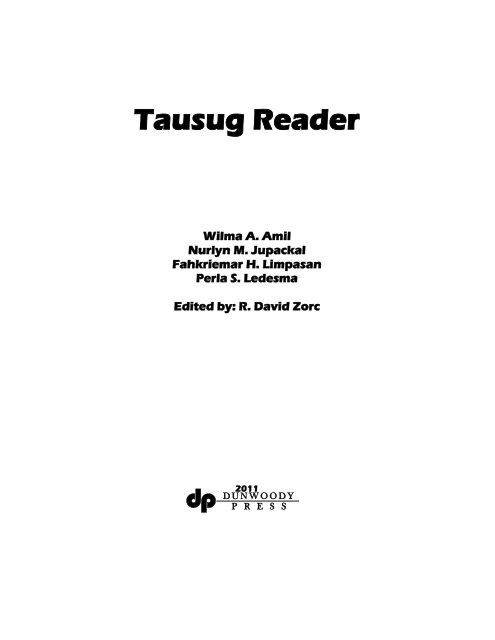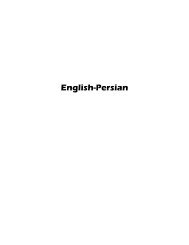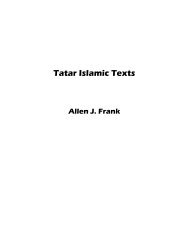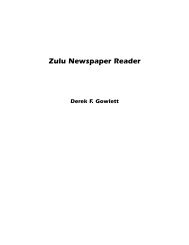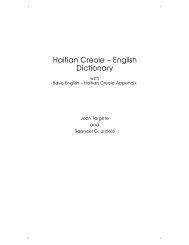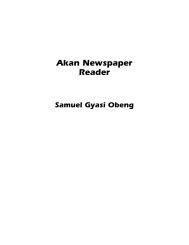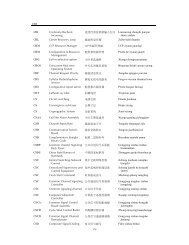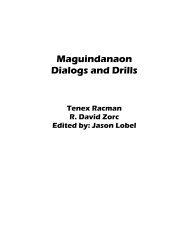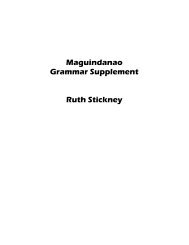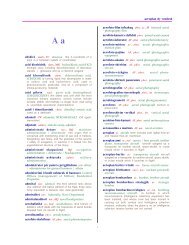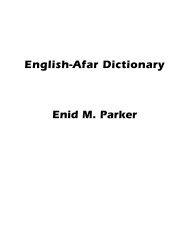Tausug Reader - Dunwoody Press Tausugs' Beliefs in the
Tausug Reader - Dunwoody Press Tausugs' Beliefs in the
Tausug Reader - Dunwoody Press Tausugs' Beliefs in the
You also want an ePaper? Increase the reach of your titles
YUMPU automatically turns print PDFs into web optimized ePapers that Google loves.
<strong>Tausug</strong> <strong>Reader</strong><br />
Wilma A. Amil<br />
Nurlyn M. Jupackal<br />
Fahkriemar H. Limpasan<br />
Perla S. Ledesma<br />
Edited by: R. David Zorc<br />
2011
<strong>Tausug</strong> <strong>Reader</strong><br />
Copyright © 2011 by AECOM, Inc.<br />
All rights reserved.<br />
No part of this work may be reproduced or transmitted <strong>in</strong> any form or by<br />
any means, electronic or mechanical, <strong>in</strong>clud<strong>in</strong>g photocopy<strong>in</strong>g and<br />
record<strong>in</strong>g, or by any <strong>in</strong>formation storage and retrieval system, without prior<br />
written permission from <strong>the</strong> copyright owner.<br />
All <strong>in</strong>quiries should be directed to:<br />
<strong>Dunwoody</strong> <strong>Press</strong><br />
6564 Loisdale Ct, Suite 500<br />
Spr<strong>in</strong>gfield, VA 22150<br />
U.S.A.<br />
ISBN: 978-1-931546-82-9<br />
Library of Congress Control Number: 2011921535<br />
Pr<strong>in</strong>ted and bound <strong>in</strong> <strong>the</strong> United States of America
Table of Contents<br />
Preface................................................................................................................. i<br />
Abbreviations .................................................................................................... ii<br />
Complex Sound Changes. ............................................................................... vi<br />
A Note On <strong>Tausug</strong> Uniques. .........................................................................viii<br />
A Note On Spanish Loanwords. .................................................................... ix<br />
Bibliography. ..................................................................................................... x<br />
Selections<br />
Selection 1. In Jaga Pitaka’ .............................................................................. 1<br />
Selection 2. Pagsa’bu s<strong>in</strong> Pamar<strong>in</strong>ta ha Sūg .................................................... 5<br />
Selection 3. Graduation ha Jolo ....................................................................... 7<br />
Selection 4. Isturi hi Toto’ ................................................................................ 9<br />
Selection 5. In Pangalay Festival ha Jolo ....................................................... 11<br />
Selection 6. In Manga Piyagbiddaan s<strong>in</strong> Mawmaas iban s<strong>in</strong><br />
Manga Anak Nila ....................................................................... 13<br />
Selection 7. Hambuuk Panglaggui ha Manga Naghih<strong>in</strong>ang ha Guwa’<br />
Hula’ ........................................................................................... 15<br />
Selection 8. Dūyan .......................................................................................... 17<br />
Selection 9. Būd Kaha’ ................................................................................... 19<br />
Selection 10. Panayam: Red Alert 2 ................................................................ 21<br />
Selection 11. Pag’anad Biya’-di<strong>in</strong> Magparāgan Motor ................................... 24<br />
Selection 12. In Ba’gu Capitol Site .................................................................. 26<br />
Selection 13. Manga G<strong>in</strong>isan Pangahagad ha Bulākaw .................................. 28<br />
Selection 14. In Baya’ Map<strong>in</strong>da ....................................................................... 30<br />
Selection 15. Kabuhi’ s<strong>in</strong> Hambuuk Bata’ Iskul Naghih<strong>in</strong>ang ....................... 32<br />
Selection 16. Ha Museum ................................................................................ 35<br />
Selection 17. Manga Sasakatan Lupa’ ha Tiyanggi ........................................ 37<br />
Selection 18. Manga Timpu ha Philipp<strong>in</strong>es ..................................................... 39<br />
Selection 19. In Niyug ...................................................................................... 41<br />
Selection 20. Manga Pangahagad s<strong>in</strong> manga Tausūg ha Mantiyanak ............ 43<br />
Selection 21. Manga Usu Ba’gu ha Manga Drama s<strong>in</strong> Pilip<strong>in</strong>as .................... 45<br />
Selection 22. In Halga’ s<strong>in</strong> Manga Duwaa ...................................................... 47<br />
Selection 23. Usaha T<strong>in</strong>da-t<strong>in</strong>da ...................................................................... 49<br />
Selection 24. Ungsud, Lawng s<strong>in</strong> Code of Muslim Personal Laws of <strong>the</strong><br />
Philipp<strong>in</strong>es .................................................................................. 51<br />
Selection 25. Adlaw Pagpuasa s<strong>in</strong> Hambuuk Muslim..................................... 53<br />
Selection 26. Manga Ipatan .............................................................................. 55<br />
Selection 27. Kabuhianan s<strong>in</strong> manga Tausūg ha Kagimbahan ....................... 57<br />
Selection 28. In Gaddung Panghiyanum Ha Lupa’ Sūg .................................. 59<br />
Selection 29. Pagtanum ha Taykud Bāy .......................................................... 61<br />
Selection 30. In Pagtagama s<strong>in</strong> Pagkaun ......................................................... 63<br />
Selection 31. In Takwim s<strong>in</strong> Tausūg: Manga Adlaw Iban Manga Bulan ....... 65<br />
Selection 32. Manga Banda Rock .................................................................... 68
Selection 33. Gun Ban ...................................................................................... 70<br />
Selection 34. Madrasa: Hambuuk Iskul s<strong>in</strong> Islam ........................................... 72<br />
Selection 35. In Computer ha Bihaun .............................................................. 74<br />
Selection 36. Balat ............................................................................................ 76<br />
Selection 37. In Pagdatung s<strong>in</strong> manga Barang Technology ............................ 78<br />
Selection 38. Anak s<strong>in</strong> Sundalu ....................................................................... 80<br />
Selection 39. Biya’-di<strong>in</strong> Magpanayam Patsa ................................................... 83<br />
Selection 40. Bāy amu <strong>in</strong> Nagdarā Sukud ....................................................... 86<br />
Selection 41. In Manga Pangaddatan s<strong>in</strong> Tausūg ha Manga Bata’-Bata’<br />
Ba’gu Piyag’anak ....................................................................... 88<br />
Selection 42. Manga Pakukus .......................................................................... 90<br />
Selection 43. Pagbuhat ..................................................................................... 92<br />
Selection 44. Foreign Policies .......................................................................... 94<br />
Selection 45. In Kahālan s<strong>in</strong> Pagboto .............................................................. 96<br />
Selection 46. Manga Call Center ..................................................................... 98<br />
Selection 47. Manga Langgit ha Manga Bata’-Bata’ .................................... 100<br />
Selection 48. Sakit Manuk ............................................................................. 102<br />
Selection 49. Unu <strong>in</strong> Cell Phone pa Kabuhi’ Natu’ ...................................... 104<br />
Selection 50. Katān Pasal Lunag .................................................................... 106<br />
Selection 51. Pag’ubat ha Pangh<strong>in</strong>ang-h<strong>in</strong>ang .............................................. 108<br />
Selection 52. Kasambuhan ha Lupa’ Sūg ...................................................... 110<br />
Selection 53. Pagh<strong>in</strong>ang Pambut .................................................................... 112<br />
Selection 54. Jīn hi Apu’ Ku .......................................................................... 114<br />
Selection 55. Pagmundu ha Video ................................................................. 116<br />
Selection 56. Pag’iskul Nurs<strong>in</strong>g ..................................................................... 118<br />
Selection 57. Tiyapuk s<strong>in</strong> Kukuk ................................................................... 120<br />
Selection 58. Manga Bāy ha Kagimbahan ..................................................... 122<br />
Selection 59. Kamatay .................................................................................... 124<br />
Selection 60. Manga Ingat-kapandayan s<strong>in</strong> Kamaasan ................................. 126<br />
Selection 61. Pagkaw<strong>in</strong> Tausūg ..................................................................... 128<br />
Selection 62. Manga Adlaw s<strong>in</strong> Haylaya ....................................................... 131<br />
Selection 63. In manga Pali-palihan S<strong>in</strong> Kamaasan Natu’ ............................ 133<br />
Selection 64. In Tuman Maana s<strong>in</strong> Jihad ha Dān s<strong>in</strong> Allah .......................... 135<br />
Selection 65. Pagh<strong>in</strong>du’ Ma<strong>the</strong>matics ha manga Bata’-Bata’ ....................... 137<br />
Selection 66. In Pangaddatan s<strong>in</strong> Tausūg ...................................................... 141<br />
Translations<br />
Selection 1. The Wallet Guard ..................................................................... 145<br />
Selection 2. Celebration of Sulu Governance .............................................. 145<br />
Selection 3. Graduation <strong>in</strong> Jolo .................................................................... 146<br />
Selection 4. Story of Toto’ ........................................................................... 146<br />
Selection 5. The Pangalay Festival <strong>in</strong> Jolo .................................................. 147<br />
Selection 6. The Differences between Parents and Their Children ............. 147<br />
Selection 7. A Tribute To Overseas Workers .............................................. 148<br />
Selection 8. Durian ....................................................................................... 149
Selection 9. Mount Kaha' ............................................................................. 149<br />
Selection 10. The Computer Game: Red Alert 2 ........................................... 150<br />
Selection 11. Learn<strong>in</strong>g How to Drive a Motorcycle ...................................... 151<br />
Selection 12. The New Capitol Site ............................................................... 151<br />
Selection 13. The Variety of <strong>Beliefs</strong> <strong>in</strong> <strong>the</strong> Shoot<strong>in</strong>g Star ............................. 152<br />
Selection 14. The Desire to Change ............................................................... 153<br />
Selection 15. Life of a Work<strong>in</strong>g Student ....................................................... 153<br />
Selection 16. At <strong>the</strong> Museum ......................................................................... 154<br />
Selection 17. Land Transportation <strong>in</strong> Jolo ..................................................... 154<br />
Selection 18. Seasons <strong>in</strong> <strong>the</strong> Philipp<strong>in</strong>es ........................................................ 155<br />
Selection 19. The Coconut Palm .................................................................... 156<br />
Selection 20. <strong>Tausug</strong>s’ <strong>Beliefs</strong> <strong>in</strong> <strong>the</strong> Mantiyanak ........................................ 156<br />
Selection 21. New Trends <strong>in</strong> Philipp<strong>in</strong>e Soap Operas ................................... 157<br />
Selection 22. The Value of Prayer ................................................................. 157<br />
Selection 23. The Sari-Sari Store Bus<strong>in</strong>ess.................................................... 158<br />
Selection 24. Dower, Accord<strong>in</strong>g to <strong>the</strong> Code of Muslim Personal<br />
Laws of <strong>the</strong> Philipp<strong>in</strong>es ............................................................ 159<br />
Selection 25. A Muslim’s Day of Fast<strong>in</strong>g ...................................................... 159<br />
Selection 26. Pets ............................................................................................ 160<br />
Selection 27. Livelihood of <strong>the</strong> <strong>Tausug</strong>s <strong>in</strong> <strong>the</strong> H<strong>in</strong>terland ........................... 161<br />
Selection 28. The Verdant Vegetation <strong>in</strong> Sulu .............................................. 161<br />
Selection 29. Backyard Garden<strong>in</strong>g ................................................................. 162<br />
Selection 30. Food Preparation ...................................................................... 163<br />
Selection 31. The <strong>Tausug</strong> Calendar: Days and Months ................................ 163<br />
Selection 32. Rock Bands ............................................................................... 165<br />
Selection 33. Gun Ban .................................................................................... 165<br />
Selection 34. Madrasa — An Islamic School ................................................ 166<br />
Selection 35. The Computer Nowadays ........................................................ 167<br />
Selection 36. Lea<strong>the</strong>r ...................................................................................... 168<br />
Selection 37. The Influx of Technological Products ..................................... 168<br />
Selection 38. The Child of a Soldier .............................................................. 169<br />
Selection 39. How to Play Patsa .................................................................... 170<br />
Selection 40. A House That Br<strong>in</strong>gs Luck ...................................................... 171<br />
Selection 41. <strong>Tausug</strong> Practices for Newly-Born Babies ............................... 172<br />
Selection 42. Bladed Weapons ....................................................................... 173<br />
Selection 43. Customary B<strong>in</strong>d<strong>in</strong>g of <strong>the</strong> Abdomen of a Pregnant Woman .. 173<br />
Selection 44. Foreign Policies ........................................................................ 174<br />
Selection 45. Election Issues .......................................................................... 175<br />
Selection 46. Call Centers .............................................................................. 175<br />
Selection 47. Vacc<strong>in</strong>es for Young Children .................................................. 176<br />
Selection 48. Avian Influenza ........................................................................ 177<br />
Selection 49. What <strong>the</strong> Cell Phone Is <strong>in</strong> Our Lives ....................................... 177<br />
Selection 50. All About Stress ....................................................................... 178<br />
Selection 51. Cur<strong>in</strong>g by Black Magic ............................................................ 179<br />
Selection 52. Development <strong>in</strong> <strong>the</strong> Prov<strong>in</strong>ce of Sulu ...................................... 179<br />
Selection 53. Pump-Boat Mak<strong>in</strong>g .................................................................. 180
Selection 54. My Grandmo<strong>the</strong>r's Genie ......................................................... 181<br />
Selection 55. Video Piracy ............................................................................. 181<br />
Selection 56. Study<strong>in</strong>g Nurs<strong>in</strong>g ...................................................................... 182<br />
Selection 57. Hidden by a Kukuk ................................................................... 183<br />
Selection 58. Houses <strong>in</strong> <strong>the</strong> Rural Areas ........................................................ 184<br />
Selection 59. Death ......................................................................................... 185<br />
Selection 60. Skills of <strong>the</strong> Elders ................................................................... 185<br />
Selection 61. <strong>Tausug</strong> Wedd<strong>in</strong>g ...................................................................... 186<br />
Selection 62. Religious Festival Days ............................................................ 187<br />
Selection 63. The Superstitions of Our Elders ............................................... 188<br />
Selection 64. The True Mean<strong>in</strong>g of Jihad <strong>in</strong> <strong>the</strong> Way of Allah ..................... 188<br />
Selection 65. Teach<strong>in</strong>g Ma<strong>the</strong>matics to Children .......................................... 189<br />
Selection 66. The Personality of <strong>the</strong> <strong>Tausug</strong> ................................................. 191<br />
Glossary .................................................................................................... 195
Preface<br />
This reader is designed to provide an <strong>in</strong>termediate student of <strong>Tausug</strong> with a<br />
broad selection of au<strong>the</strong>ntic articles toge<strong>the</strong>r with all necessary lexical and<br />
grammatical <strong>in</strong>formation to decipher <strong>the</strong>m.<br />
The selections are rated between levels 2 to 3 plus accord<strong>in</strong>g to <strong>the</strong><br />
standards def<strong>in</strong>ed by <strong>the</strong> Interagency Language Roundtable (ILR) or<br />
American Council on <strong>the</strong> Teach<strong>in</strong>g of Foreign Languages (ACTFL).<br />
These selections can also be used productively to supplement or lead <strong>in</strong>to<br />
Intensive <strong>Tausug</strong>: A Pedagogical Grammar of <strong>the</strong> Language Of Jolo,<br />
Philipp<strong>in</strong>es by Carl R. Galvez Rub<strong>in</strong>o (published by <strong>Dunwoody</strong> <strong>Press</strong> <strong>in</strong><br />
2006; revised edition forthcom<strong>in</strong>g).<br />
The selections are orig<strong>in</strong>al creations by three authors. Every effort has been<br />
made to offer <strong>the</strong> widest range of genres for different sett<strong>in</strong>gs: Culture and<br />
Society, Politics, Economics, Local History, Science and Technology,<br />
Defense, Geography, and <strong>the</strong> Environment. The selections have not been<br />
changed or abbreviated from <strong>the</strong>ir orig<strong>in</strong>als, and great care has been made<br />
to correspond <strong>the</strong>m exactly to <strong>the</strong> record<strong>in</strong>gs (available separately).<br />
The first part of this book conta<strong>in</strong>s <strong>the</strong> sixty-six selections with <strong>in</strong>dividual<br />
vocabularies. Words are entered <strong>in</strong> <strong>the</strong> order of <strong>the</strong>ir first appearance.<br />
Please note that <strong>the</strong> glosses are purposely literal, especially for verbs, s<strong>in</strong>ce<br />
<strong>the</strong> three passive voices are idiosyncratic to Philipp<strong>in</strong>e languages. The<br />
standard idiomatic or free rendition of <strong>the</strong>se verbs <strong>in</strong> English will be found<br />
<strong>in</strong> each respective translation. Once glossed, a word will not be re-glossed<br />
unless <strong>the</strong>re is a substantial change <strong>in</strong> its mean<strong>in</strong>g. Note also that words<br />
appear<strong>in</strong>g <strong>in</strong> <strong>the</strong> <strong>Tausug</strong>-English Dictionary: Kabtangan Iban Maana<br />
(1994 edition) by Irene U. Hassan, Seymour A. Ashley, and Mary L.<br />
Ashley are generally not glossed here<strong>in</strong>.<br />
The second part of this book consists of <strong>the</strong> translations of each selection.<br />
For <strong>the</strong> most part, <strong>the</strong>y are free and rendered <strong>in</strong> standard American English.<br />
The third and f<strong>in</strong>al part of this book is an overall glossary <strong>in</strong> alphabetical<br />
order, represent<strong>in</strong>g a compilation of all <strong>in</strong>dividual vocabularies.<br />
i
Abbreviations<br />
’ — glottal stop<br />
~ — or<br />
abr — abbreviation<br />
abs — abstract noun<br />
adj — adjective<br />
adv — adverb<br />
art — an article; See: cm<br />
atr — attributive, used <strong>in</strong> a modify<strong>in</strong>g function, but not a true adjective<br />
Bis — a Bisayan (ambiguously Cebuano or Hiligaynon) loanword<br />
body — name of a part of <strong>the</strong> body (human or animal)<br />
card — card<strong>in</strong>al numeral (e.g., one, two, ten, sixty)<br />
Ceb — Cebuano loanword<br />
Cf: — confer with<br />
Chav — Chavacano loanword<br />
circum — circumfix<br />
cm — case marker [ ~ "art"]<br />
cmp — compound (two words strung toge<strong>the</strong>r as a complete unit)<br />
col — collective noun "<strong>the</strong> comb<strong>in</strong>ation of all X's"<br />
comp — comparative (used <strong>in</strong> compar<strong>in</strong>g one th<strong>in</strong>g aga<strong>in</strong>st ano<strong>the</strong>r)<br />
CSLI — Center for <strong>the</strong> Study of Language and Information<br />
curse — a curse, <strong>in</strong>sult, or condemnation hurled at someone<br />
date — date (i.e., day of <strong>the</strong> week, month of <strong>the</strong> year)<br />
dial — dialect<br />
dim — dim<strong>in</strong>utive<br />
direction — a specific form of location word (e.g., north, south, east, west,<br />
etc.)<br />
dist — distributive verb (<strong>in</strong>flected with mang-, nang-, or pang-)<br />
dist loc — distritutive verb (<strong>in</strong>flected with mang- -an, pang- -an)<br />
dp — discourse particle<br />
enum — enumerative (a noun that functions like a numeral)<br />
exis — existential predicate: There is, has, hav<strong>in</strong>g<br />
exis poss — existential possessive<br />
expr — expression (three or more words strung toge<strong>the</strong>r express<strong>in</strong>g a s<strong>in</strong>gle<br />
idea) [Contrast: phr]<br />
ext — an extended mean<strong>in</strong>g<br />
fem — female, fem<strong>in</strong><strong>in</strong>e, referr<strong>in</strong>g to a woman<br />
Hil — Hiligaynon or Ilonggo loanword<br />
idiom — a word or group of words that functions as a s<strong>in</strong>gle idea, not<br />
readily understandable outside of <strong>the</strong> culture<br />
imp — imperative or command form of <strong>the</strong> verb<br />
<strong>in</strong>ch — <strong>in</strong>choative verb (denot<strong>in</strong>g becom<strong>in</strong>g more so)<br />
<strong>in</strong>def — an <strong>in</strong>def<strong>in</strong>ite form<br />
<strong>in</strong>f — <strong>in</strong>f<strong>in</strong>itive form of <strong>the</strong> verb (to VERB)<br />
ii
<strong>in</strong>str — <strong>in</strong>strumental focus, <strong>the</strong> object is mov<strong>in</strong>g away from <strong>the</strong> speaker or<br />
is an <strong>in</strong>strument used <strong>in</strong> perform<strong>in</strong>g <strong>the</strong> action (<strong>in</strong>flected with hi-,<br />
hika-, hipag-, kiya-, etc.)<br />
<strong>in</strong>tens — <strong>in</strong>tensive or "very" much so<br />
<strong>in</strong>tj — <strong>in</strong>terjection or exlamation<br />
<strong>in</strong>tr — <strong>in</strong>transitive verb (one that does not take a direct object)<br />
k<strong>in</strong> — a k<strong>in</strong> term (related by blood or by marriage)<br />
lit — literal mean<strong>in</strong>g; literally<br />
loc — a location (marked with ha); locative focus (<strong>in</strong>flected with -an, -i)<br />
masc — male, mascul<strong>in</strong>e, referr<strong>in</strong>g to a man<br />
meteo — meteorological word (express<strong>in</strong>g wea<strong>the</strong>r conditions, e.g., ra<strong>in</strong>,<br />
w<strong>in</strong>dy, monsoon, typhoon, etc.)<br />
Mex — Mexican Spanish<br />
n — noun<br />
n cmp idiom — compound noun that does not mean what its elements<br />
imply<br />
n cmp poss — a noun compounded with a possessive pronoun<br />
n cmp time — a noun compound that expresses some temporal dimension<br />
or relationship<br />
n loc — a noun formed with <strong>the</strong> locative suffix -an or any noun referr<strong>in</strong>g<br />
specifically to some place or geographic location<br />
n phr — noun phrase<br />
n pl — a noun <strong>in</strong> its plural form<br />
n, adj — noun also function<strong>in</strong>g attributively (i.e., as an adjective)<br />
n, v — a noun stem that also functions as a verb stem (hav<strong>in</strong>g <strong>the</strong> same<br />
overall mean<strong>in</strong>g <strong>in</strong> English, e.g., ulan "ra<strong>in</strong>")<br />
neg — a negative word "no; not; don't!; never"<br />
neg adj phr — an attributive phrase that functions like an adjective<br />
neg exis — a negative existential "none; <strong>the</strong>re is none"<br />
neg expr — a comb<strong>in</strong>ation of 3 or more words express<strong>in</strong>g a s<strong>in</strong>gle idea<br />
neg <strong>in</strong>tj — a negative <strong>in</strong>terjection<br />
neg preverb — a negative preverb<br />
neg pro — a negative plus a pronoun<br />
num — numeral, number<br />
num adv — adverbial use of a numeral (e.g., secondly, by <strong>the</strong> hundreds, ten<br />
each, three times [multiplicative])<br />
num cmp — numeral compound, a number composed of two or more parts<br />
num prf — a prefix used with numeral stems<br />
obl — an oblique form (i.e., <strong>in</strong> <strong>the</strong> locative) [Case 3]<br />
ord — ord<strong>in</strong>al numeral (e.g., first, second, tenth, sixtieth)<br />
orig — orig<strong>in</strong>ally<br />
pass — passive or object focus verb (<strong>in</strong>flected with -a, -hun, -un, etc.)<br />
past — past tense form (sometimes called perfect or perfective)<br />
pejor — pejorative, rude, crude ~ negative term or expression<br />
phr — phrase (three or more words that form a complex idea or function as<br />
a s<strong>in</strong>gle part of speech) [Contrast: cmp, expr]<br />
iii
pl — plural form or marker<br />
pn — personal name ~ proper noun<br />
pn loc — name of a geographic location: town, city, prov<strong>in</strong>ce, country, etc.<br />
poss — possessive [Case 2]<br />
pot — potential or potentive mood "can, able to; could;" also denotes an<br />
accidental ~ co<strong>in</strong>cidental action, e.g., "happened to VERB," also nonvolitional<br />
causation<br />
prep — a prepositional element (a noun function<strong>in</strong>g like a preposition <strong>in</strong><br />
English)<br />
pres — present tense form, usually formed with CV- reduplication<br />
preverb — a preverb (a form that comes before and governs ano<strong>the</strong>r verb as<br />
part of an entire verb phrase)<br />
prf — prefix<br />
pro — pronoun<br />
pro <strong>in</strong>def — an <strong>in</strong>def<strong>in</strong>ite pronoun<br />
pro obl — an oblique pronoun<br />
pro phr — pronoun phrase<br />
pro poss — a possessive pronoun<br />
pro redup — a reduplicated pronoun<br />
proverb — proverb<br />
proverb idiom — a proverb with a highly idiomatic mean<strong>in</strong>g<br />
qw — an <strong>in</strong>terrogative or question word<br />
qw cmp — a question composed of two words or created by compound<strong>in</strong>g,<br />
e.g., bukun ka "isn't it so?"<br />
qw expr — a question composed of three or more words<br />
qw loc — a question ask<strong>in</strong>g about place, position, or location<br />
qw phr — a question composed of three or more words<br />
qw pn — a question word ask<strong>in</strong>g about a personal name or proper noun<br />
qw time — a question word ask<strong>in</strong>g about time<br />
qw v — a question word function<strong>in</strong>g as a verb<br />
recip — reciprocal noun, pronoun, or verb imply<strong>in</strong>g "each o<strong>the</strong>r," "one<br />
ano<strong>the</strong>r" (subject and object <strong>in</strong>teract)<br />
redup — any word that is repeated or reflects reduplication of its root or<br />
stem<br />
redup x — a word that appears to be a reduplication but bears little or no<br />
connection to any root<br />
relig — a word relat<strong>in</strong>g to religion or supernatural beliefs (<strong>in</strong>clud<strong>in</strong>g terms<br />
reflect<strong>in</strong>g pre-Islamic animism)<br />
rw —root word<br />
See: — see <strong>the</strong> word or example cited<br />
sg — s<strong>in</strong>gular form or marker, referr<strong>in</strong>g to one entity<br />
SIL — Summer Institute of L<strong>in</strong>guistics<br />
SIPL — Studies <strong>in</strong> Philipp<strong>in</strong>e L<strong>in</strong>guistics<br />
soc — social or ethnological label<br />
sp — a species of animal or plant<br />
Span — Spanish loanword, probably through Chavacano<br />
iv
st — stative (reflect<strong>in</strong>g some physical feel<strong>in</strong>g, state, or emotion)<br />
st atr — a stative-attributive form<br />
suf — suffix<br />
sup — superlative adjective, "most" ~ "greatest"<br />
syn — synonym, form with <strong>the</strong> same or a similar mean<strong>in</strong>g<br />
tag — <strong>the</strong> form of a question that assumes an answer, e.g., isn't it so?<br />
Tag — Tagalog loanword<br />
time — temporal implication, time expression<br />
tr — transitive verb (one that takes a direct object)<br />
Tsg — <strong>Tausug</strong><br />
typo — a typographical error or possible misspell<strong>in</strong>g<br />
v — verb<br />
v dist pres — distributive verb <strong>in</strong> <strong>the</strong> present tense (nangCV-)<br />
v loc — locative verb (<strong>in</strong>flected with <strong>the</strong> -an or -i suffixes)<br />
v root — verb root<br />
v st — stative verb<br />
v st loc — stative verb <strong>in</strong>flected with ka- -an forms<br />
var — variant of<br />
var spel: — variant spell<strong>in</strong>g, an alternate way of spell<strong>in</strong>g <strong>the</strong> word<br />
vn — verbal noun (usually marked with prefix pag-)<br />
vn prf — verbal noun ~ gerund prefix<br />
v
Complex Sound Changes<br />
There are five important sound changes (i.e., morphophonemic changes<br />
by l<strong>in</strong>guists) which may prove difficult for some students of this language.<br />
It is important to understand that some words change quite drastically from<br />
<strong>the</strong>ir root form, and <strong>the</strong> student will not readily f<strong>in</strong>d such words <strong>in</strong> a<br />
dictionary where words are listed under <strong>the</strong>ir root, ra<strong>the</strong>r than <strong>in</strong><br />
alphabetical order.<br />
Before five consonants, <strong>the</strong> mangCV- prefix actually takes <strong>the</strong> shape of<br />
mangVng-, while with mang- and pang-, <strong>the</strong> first consonant of <strong>the</strong> root is<br />
lost.<br />
*B*<br />
hipamāk "meet" < bāk + hipang-<br />
mamimī "buyer" < bī + mangCV-<br />
mamomoto "voter" < boto + mangCV-<br />
mamumunu’ "killer, murderer" < bunu’ + mangCV-<br />
*K*<br />
mangangalang "s<strong>in</strong>ger" < kalang + mangCV-<br />
mang<strong>in</strong>gita’ "fortune-teller, seer" < kita’+ mangCV-<br />
mangungugut "extortionist" < kugut "extort" + mangCV-<br />
mangunguut "pickpocket" < kuut + mangCV-<br />
nangungura' "rid<strong>in</strong>g a horse" < kura' + nangCV-<br />
*P*<br />
mamula "blush, turn red: < pula + mang-<br />
namudji "praised, glorified" < pudji + nang-<br />
pamalihala' "tak<strong>in</strong>g care" < palihala’ + pang-<br />
*S*<br />
mananasal "smith" < sasal + mangCV-<br />
man<strong>in</strong>iyul "one who fishes with a f<strong>in</strong>e net" < siyul + mangCV-<br />
*T*<br />
mananahi’ "seamstress, tailor" < tahi’+ mangCV-<br />
mananawal "medic<strong>in</strong>e man" < tawal+ mangCV-<br />
The prefixes mang-, mangCV-, and pang- appear unchanged before all<br />
vowels and two consonants /h/ and /l/. See Rub<strong>in</strong>o 2006:121 from which<br />
several of <strong>the</strong>se examples are taken.<br />
*A*<br />
mangasubu "ask" < asubu + mang-<br />
mangatubang "face each o<strong>the</strong>r" < atubang + mang-<br />
panganud "cloud" < anud + pang-<br />
pangandul "trust, confidence" < andul + pang-<br />
*I*<br />
mangihi’ "ur<strong>in</strong>ate" < ihi’ + mang-<br />
vi
mang<strong>in</strong>gista’ "fisherman" < ista’ + mangCV-<br />
mangiklug "lay an egg" < iklug "egg" + mang-<br />
mangiban "accompany" < iban + mang-<br />
*U*<br />
mangungubat "shaman, medic<strong>in</strong>e man" < ubat + mangCV-<br />
mangungudju’ "mocker" < udju’ + mangCV-<br />
mangungutang "debtor, borrower" < utang + mangCV-<br />
pangukabi "open<strong>in</strong>g" < ukab + pang- -i<br />
*D*<br />
mangdāg "climb" < dāg + mang-<br />
makapangdā’dā’ "offend, hurt s.o.'s feel<strong>in</strong>gs" < dā’dā’ + makapang-<br />
nangda’gan "pressed down on s.t." < da’gan + nang-<br />
pangdakup "elopement" < dakup + pang-<br />
*G*<br />
panggaga "discipl<strong>in</strong>e, control" < gaga + pang-<br />
manggalit "shout" < galit + mang-<br />
nanggubat "attacked" < gubat + nang-<br />
*J*<br />
mangjawab "answer" < jawab + mang-<br />
mangjahulaka' "maltreat s.o." < jahulaka' + mang-<br />
mangjiyara "kiss <strong>the</strong> hand of one's elders on a feast day (as a sign of<br />
respect" < jiyara + mang-<br />
EXCEPTION:<br />
manjari "can, able to" < jari + mang- [Var mangjari]<br />
*H*<br />
manghabun "ambush, overwhelm" < habun + mang-<br />
manghaplas "ba<strong>the</strong>, take a sponge bath" < haplas + mang-<br />
manghih<strong>in</strong>du’ "<strong>in</strong>structor, teacher" < h<strong>in</strong>du’ + mangCV-<br />
manghuhukum "judge" < hukum + mangCV-<br />
*L*<br />
manglalanggal "violator" < langgal + mangCV-<br />
manglalappas "redeemer" < lappas + mangCV-<br />
manglulunggu’ "terrorists" < lunggu’ + mangCV-<br />
panglaggui "tribute" < laggu’ + pang- -i<br />
The Months of <strong>the</strong> Year<br />
Note that <strong>the</strong> names of <strong>the</strong> months of <strong>the</strong> year <strong>in</strong> <strong>Tausug</strong> are adopted<br />
Islamic terms, not Spanish (as is <strong>the</strong> case <strong>in</strong> <strong>the</strong> vast majority of Philipp<strong>in</strong>e<br />
languages). Throughout this <strong>Reader</strong>, when a Western date is referred to (as<br />
an American or Christian Filip<strong>in</strong>o would recognize <strong>the</strong>m), an English word<br />
is used:<br />
January, February, March, April, May, June, July,<br />
August, September, October, November, December<br />
vii
The Islamic names have religious signficance:<br />
Muharram — first month (hav<strong>in</strong>g thirty days)<br />
Sappal, Shafar, Syafar — second month<br />
Rabiyul — quasi-prefix or compound word used on <strong>the</strong> third ~<br />
fourth months [Arabic "spr<strong>in</strong>g"]<br />
Rabiyul Awal, Rabi Al Awal — third month<br />
Rabiyul Ahil, Rabi Al Ahil — fourth month<br />
Ahil — (quasi-suffix or last compound word used on <strong>the</strong> fourth<br />
and sixth months)<br />
Jumadil Awal, Jumadir Awal — fifth month<br />
Jumadil — (quasi-prefix or first compound word on <strong>the</strong> fifth<br />
and sixth months)<br />
Jumadil Ahil, Jumadil Ahir — sixth month<br />
Rajab — seventh month<br />
Sa’ban — eighth month (hav<strong>in</strong>g 29 days)<br />
Ramadan, Ramadhan — Ramadhan, <strong>the</strong> fast<strong>in</strong>g month (n<strong>in</strong>th<br />
month, hav<strong>in</strong>g 29 or 30 days)<br />
Sawwal, Shawwal — tenth month (hav<strong>in</strong>g 29 days)<br />
Julkaidda, Julka’idda — eleventh month<br />
Julhadji’, Julhajji’ — twelfth month<br />
A Note On <strong>Tausug</strong> Uniques<br />
While <strong>Tausug</strong> is a language with<strong>in</strong> <strong>the</strong> Bisayan family (most closely related<br />
to Butuan), it has at least a dozen unique forms that dist<strong>in</strong>guish it from<br />
Bisayan dialects and also from all o<strong>the</strong>r Philipp<strong>in</strong>e languages.<br />
<strong>Tausug</strong> English Bisayan (usual)<br />
amu<strong>in</strong> which, who, that amu (ang)<br />
[Subord<strong>in</strong>ates what follows to that<br />
which precedes]<br />
atawa or Span u / o<br />
awn (aun) <strong>the</strong>re is may / igwa<br />
bayá’ + ma- like, want -ruyag<br />
huun yes huu<br />
iban and kag<br />
kagunahan must; need k<strong>in</strong>ahanglan<br />
ka<strong>in</strong>gatan know hibadu, sayud<br />
kawhaan [+Ceb dial] twenty (20) kaduhaan, Span baynte<br />
manjari can, able mahímu'<br />
sagwa’ (sagua’) but apang, Span pero<br />
sīn money pirak, Span kwarta<br />
subay should dapat<br />
viii
A Note On Spanish Loanwords<br />
<strong>Tausug</strong>, unlike its Bisayan and o<strong>the</strong>r Philipp<strong>in</strong>e relatives, shows its greatest<br />
<strong>in</strong>fluence from <strong>the</strong> Samal language family, e.g., Samal, Yakan, and also<br />
from direct contact with Indonesian and/or Malay. There is no evidence for<br />
any direct <strong>in</strong>fluence from <strong>the</strong> Spanish, because <strong>the</strong> <strong>Tausug</strong>s staunchly<br />
resisted all <strong>in</strong>vaders, both Spanish and American. However, <strong>the</strong> <strong>Tausug</strong>-<br />
English Dictionary erroneously attributes what are essentially Spanish<br />
loans to Tagalog, whereas <strong>the</strong> provenance of such borrow<strong>in</strong>gs is most likely<br />
to be from trade and contact with <strong>the</strong> nearby Chavacano (a Spanish and<br />
Asturian creole language).<br />
<strong>Tausug</strong> English Spanish<br />
āmu employer, boss amo "master, boss"<br />
bayla dance bailar<br />
bisita visitor, guest visita<br />
būla ball bola<br />
dip<strong>in</strong>di depend (on ~ upon) depender<br />
duru streng<strong>the</strong>n, grow stronger duro "hard, tough,<br />
strong"<br />
kampu base, field campo "countryside"<br />
kāru-kāru carts carro<br />
lamisahan table la mesa "<strong>the</strong> table"<br />
mantakilya jam, jelly, margar<strong>in</strong>e mantequilla "butter"<br />
pamilya family familia<br />
pasyal stroll, walk; visit pasear<br />
prublima problem problema<br />
pusti post poste<br />
s<strong>in</strong>i movie c<strong>in</strong>e "c<strong>in</strong>ema, <strong>the</strong>ater"<br />
tambutsu muffler, exhaust pipe tambucho "escape<br />
hatch"<br />
tarabahu work trabajo<br />
timpu era, period of time tiempo<br />
usal use usar<br />
For hundreds of parallel citations, consult <strong>the</strong> Chavacano <strong>Reader</strong> (Miravite<br />
et al. 2009. <strong>Dunwoody</strong> <strong>Press</strong>).<br />
ix
Bibliography<br />
Abubakar, Norma M. 1969. The segmental phonemes of <strong>Tausug</strong> and<br />
English: a constrastive study. Unpublished MA <strong>the</strong>sis, Silliman<br />
University, Dumaguete City. [SIL#140] 2/5/2004.<br />
Alvarez, Teresa, ed. 2005. Harraps' Spanish and English Dictionary.<br />
New York: McGraw Hill.<br />
Anonymous. "<strong>Tausug</strong> sentences," [62 pages; author unknown <strong>in</strong> Cornell<br />
Wason Library PL 6044.T 2T17 +<br />
Armour, Malcolm S. 1984. A comparison of narrative and hortatory<br />
discourse <strong>in</strong> <strong>Tausug</strong>. Unpublished MA <strong>the</strong>sis, University of<br />
Texas, Arl<strong>in</strong>gton. xiii +197 lvs. [SIL#286] 2/5/2004.<br />
Ashley, Lois. 1963. "<strong>Tausug</strong> substantive phrases." Manila: SIL. 5 lvs. [SIL<br />
library #296; See also SIL# 300, 301, 302, 1593, 3434] 2/5/2004.<br />
Ashley, Seymour. 1964. "A descriptive analysis of <strong>Tausug</strong>." Manila: SIL<br />
library. 18 lvs. [SIL #297 See also 1593, 3434] 2/5/2004<br />
–. 1973a. "A case classification of <strong>Tausug</strong> verbs." Sulu Studies 2:70-85.<br />
[SIL #298]; orig: A Case Classification of <strong>Tausug</strong> Verbs: Prepublication<br />
ms. 27 pages; 6 page bib and notes.<br />
–. 1973b. "Notes on <strong>Tausug</strong> orthography." Sulu Studies 2:86-94. [SIL<br />
#299] 2/5/2004<br />
Ashley, Seymour and Lois Ashley. 1963a. "The phonemes of <strong>Tausug</strong>." In<br />
Papers on Philipp<strong>in</strong>e Languages 1, ed. by Elmer Wolfenden, 7-<br />
17. Manila: ILT and SIL. [SIL #300] 2/5/2004<br />
–. 1963b. "The relationship of dramatis personae to voice and focus<br />
categories of verbal <strong>in</strong>flection <strong>in</strong> <strong>Tausug</strong>." Manila: SIL. 14 lvs.<br />
[SIL #301] 2/5/2004<br />
–. 1971. "Outl<strong>in</strong>e of sentence types of <strong>Tausug</strong>." Philipp<strong>in</strong>e Journal of<br />
L<strong>in</strong>guistics [PJL] 2.1:44-91. [SIL #302] 2/5/2004<br />
Constant<strong>in</strong>o, Ernesto Andres, comp. 1980. A <strong>Tausug</strong>-English Dictionary.<br />
Diliman, Quezon City: UP. 332 pp. [SIL #944] 2/5/2004<br />
Copet, Rene. 1957. <strong>Tausug</strong> Dictionary. Jolo, Sulu: Notre Dame of Jolo<br />
<strong>Press</strong>. 333 pp. [SIL #949] 2/5/2004<br />
Corro, Anicia del. 1976. Review of: <strong>Tausug</strong>-English Dictionary:<br />
Kabtangan Iban Maana (Hassan, Ashley & Ashley). Philipp<strong>in</strong>e<br />
Journal of L<strong>in</strong>guistics (PJL) 7.1/2:93-94.<br />
Cowie, Andson. 1893. English-Sulu-Malay Vocabulary. London: THEO.<br />
193 pages.<br />
Damsani, Maduh, Efren Alawi, and Gerard Rixhon. n.d. Hangdangaw<br />
<strong>Tausug</strong> text.<br />
Ew<strong>in</strong>g, J. Frankl<strong>in</strong>. 1955. "Notes on <strong>the</strong> <strong>Tausug</strong> of Siasi <strong>in</strong> particular and<br />
<strong>the</strong> Moros of <strong>the</strong> Sou<strong>the</strong>rn Philipp<strong>in</strong>es <strong>in</strong> general," <strong>in</strong> M<strong>in</strong>danao<br />
Conference, 78-79. Chicago: University of Chicago. [SIL #1236]<br />
Hassan, Irene, Nurhadan Halud, Seymour Ashley, and Lois Ashley,<br />
compilers. 1975. <strong>Tausug</strong>-English dictionary: Kabtangan iban<br />
maana. Quezon City: SIL. [SIL #1593] [789 pp.]<br />
x
Hassan, Irene U., Nurhadan Halud, Seymour A. Ashley, and Mary L.<br />
Ashley, compilers. 1994. <strong>Tausug</strong>-English dictionary: Kabtangan<br />
iban maana. Manila: Summer Institute of L<strong>in</strong>guistics. Sulu<br />
Studies 6. [688 pp]<br />
Julpatta, Malangka and Malcolm S. Armour. 1978. "<strong>Tausug</strong>: Text 1<br />
(folktale texts)." Studies <strong>in</strong> Philipp<strong>in</strong>e L<strong>in</strong>guistics (SIPL)<br />
2.2:180-92. [SIL #1945]<br />
Kamlian, Jamail. 1996. “The Economic Aspects of <strong>the</strong> <strong>Tausug</strong> Traditional<br />
<strong>Beliefs</strong>, Rituals and Practices.” In Lim, J. ed. The M<strong>in</strong>danao<br />
Forum, XI.1.<br />
Karim. n.d. "<strong>Tausug</strong> sentences" [1 page]<br />
Kasman, Edward Salkiya. 1962 "Birth and death rituals among <strong>the</strong> <strong>Tausug</strong>s<br />
of Siasi." Unitas 35:291-340. [SIL #1963]<br />
Kroeger, Paul. 1993. “Phrase Structure and Grammatical Relations <strong>in</strong><br />
Tagalog.” CSLI Publications. Stanford, California.<br />
L<strong>in</strong>k, Francis L. 1924. ms. Abstract of a portion of <strong>the</strong> Sulu Dialect.<br />
[Manuscript 85 pages]<br />
Manguilimotan, Erlyn Q. n.d. “Syntactic Representation of Simple Verbal<br />
<strong>Tausug</strong> Sentences Us<strong>in</strong>g Lexical-Functional Grammar<br />
Formalism.” Ms. Ateneo de Zamboanga University.<br />
Medes, Aseron. n.d. "<strong>Tausug</strong> words/sentences" [1 page]<br />
Miravite, Rommel M., Ulysses Cl<strong>in</strong>t N. Sanchez, Day S. Tardo, Shirven<br />
John B. Viloria, and Fr. David John M. Delos Reyes, S.J. 2009.<br />
Chavacano <strong>Reader</strong>. Spr<strong>in</strong>gfield, VA: <strong>Dunwoody</strong> <strong>Press</strong>.<br />
Moody, David C. 1984. "The Suluk (<strong>Tausug</strong>) language." <strong>in</strong> Julie K. K<strong>in</strong>g<br />
and John Wayne K<strong>in</strong>g (eds.), Languages of Sabah: A survey<br />
report, 75-84. Pacific L<strong>in</strong>guistics C, 78. Canberra: Australian<br />
National University.<br />
Peneyra, Irma U. 1992. A Grammatical Sketch of <strong>the</strong> <strong>Tausug</strong> Language.<br />
The Archive, UP Diliman. [55 double spaced pages]<br />
Rub<strong>in</strong>o, Carl R. Galvez. 2006. Intensive <strong>Tausug</strong>: A Pedagogical<br />
Grammar of <strong>the</strong> Language of Jolo, Philipp<strong>in</strong>es. Spr<strong>in</strong>gfield, VA:<br />
<strong>Dunwoody</strong> <strong>Press</strong>. [xv + 419 pages]<br />
Summer Institute of L<strong>in</strong>guistics and M<strong>in</strong>istry of Education and Culture.<br />
1979. Languages of <strong>the</strong> Sou<strong>the</strong>rn Gateway: Chavacano, S<strong>in</strong>ama,<br />
<strong>Tausug</strong>, Yakan. Philipp<strong>in</strong>es: Marshburn <strong>Press</strong>. [117 pages]<br />
Sundita, Christopher Allen. 2002. In Bahasa Sūg: An Introduction to<br />
<strong>Tausug</strong>. Lobel & Tria Partnership, Co. Manila: Philipp<strong>in</strong>es. ISBN<br />
971-92226-6-2.<br />
Tawasil, Sapii, Seymour Ashley and Lois Ashley. 1978. "<strong>Tausug</strong>: Text 2<br />
(folktale texts)." SIPL 2.2:192-201. [SIL #3434]<br />
Tsuchida, Shigeru. 1964-1975. "Unpublished MS of 513-item vocabulary<br />
(researched <strong>in</strong> 1962 by Tsuchida) of Isnag (2 dialects), Ibanag (2<br />
dialects), Kal<strong>in</strong>ga (2 dialects), Gaddang, Ilokano, Kapampangan,<br />
Bikol (2 dialects), Koyonen, Aklanon (2 dialects), Ilonggo (2<br />
xi
dialects), K<strong>in</strong>aray-a, Waray, Maranaw, Mag<strong>in</strong>danaw, Manobo<br />
(Tagabawa), <strong>Tausug</strong>, and Samal."<br />
Usman, Saripul. n.d. "<strong>Tausug</strong> laundry story." [1 page transcript of<br />
record<strong>in</strong>g]<br />
–. n.d. "<strong>Tausug</strong> notes." [2 pp.]<br />
Yamada, Yukihiro. n.d. Vocabularies of 28 Philipp<strong>in</strong>e language groups<br />
<strong>in</strong>clud<strong>in</strong>g: Maranaw, Mag<strong>in</strong>danaw, <strong>Tausug</strong>, etc. Np. [SIL #3822]<br />
Yamashita, Michiko and Ibno I. Husse<strong>in</strong>. 1988. <strong>Tausug</strong>u-go Kaiwa<br />
Renshuchi [Pag-anad s<strong>in</strong> Pagbissara s<strong>in</strong> Bahasa Tau-sug / A<br />
Drill Book for <strong>Tausug</strong> Conversation]. Tokyo: Daigakushor<strong>in</strong>. ix<br />
+ 138 pp. [SIL #3876]<br />
Yap, Priscilla (Mrs.). 1971. "<strong>Tausug</strong> sentences." [1 page, double sided]<br />
Zorc, R. David. 1971a. "Ideas on <strong>Tausug</strong>." [1 page = 50% cognates with<br />
Palawano; *h-preserv<strong>in</strong>g; *e > u; *R > g]<br />
–. 1971b. "Palawano-<strong>Tausug</strong> cognate chart" [1 page double sided]<br />
–. 1971c. "<strong>Tausug</strong> Verb <strong>in</strong>flection paradigm" [1 page]<br />
–. 1971d. "Proto-Austronesian worksheet for <strong>Tausug</strong>; Informant Mrs.<br />
Priscilla Yap.]<br />
–. 1971e. "Proto-Philipp<strong>in</strong>e worksheet for <strong>Tausug</strong>." [8 pages, Informant<br />
Mrs. Priscilla Yap.]<br />
–. 1976. The Bisayan Dialects of <strong>the</strong> Philipp<strong>in</strong>es: Subgroup<strong>in</strong>g and<br />
Reconstruction. Pacific L<strong>in</strong>guistics C.44.<br />
xii
In Jaga Pitaka’<br />
Ina’: Unu <strong>in</strong> huhulmatan dīhil kaymu hi Babu’ Ubay mu?<br />
1<br />
Selection 1<br />
Anak: Tagad! Iyuukab ku pa <strong>in</strong>i. Hātiku pitaka’ <strong>in</strong>i. Huun, maray’ pitaka’.<br />
Ina’: Bang yan pitaka’ maray’ awn sīn ha lawm.<br />
Anak: Bang bihadtu, iyusal niya tagna’ <strong>in</strong> huhulmatan niya kāku’.<br />
Ina’: Bukun bihadtu, anak. Liyuunan niya yan sīn ha supaya awn jaga<br />
pitaka’.<br />
Anak: Unu <strong>in</strong> jaga pitaka’?<br />
Ina’: Pitaka’ <strong>in</strong> huhulmatan kaymu?<br />
Anak: Huun, pitaka’ <strong>in</strong>i, <strong>in</strong>a’. Awn sambil hang gatus pilak ha lawm.<br />
Ina’: Amu na tuud yan <strong>in</strong> jaga pitaka’. Sīn siya pila-pila na. Pagbutangun<br />
siya ha lawm magjaga s<strong>in</strong> pitaka’. Hangkan tiyawag siya jaga pitaka’.<br />
Anak: Na, mayta’ subay awn jaga pitaka’?<br />
Ina’: Lawng nila bang awn jaga s<strong>in</strong> pitaka’ mu di’ <strong>in</strong>i kaubusan sīn. Awn<br />
sadja sīn hikaluun mu ha lawm. Hangkan apabila awn ba’gu pitaka’ subay<br />
tuud awn jaga. Di’ mu manjari <strong>in</strong>i gastuhun. Bang mu <strong>in</strong>i usalun, subay<br />
kaw mamī ba’gu, pasal pangahagari <strong>in</strong>i s<strong>in</strong> way na sumūd sīn pa pitaka’<br />
mu. Di’ mu manjari sambian atawa usalun <strong>in</strong> jaga pitaka’ hipamī mu unuunu<br />
na. Subay mu tuud <strong>in</strong>i di’ tangkugun. Subay <strong>in</strong>i hitaw’ ha pitaka’ mu<br />
saumul.<br />
Vocabulary<br />
<strong>in</strong> cm <strong>the</strong> [topic case mark<strong>in</strong>g<br />
particle for common nouns]<br />
jaga ! n guard, watchman; patrol<br />
@ vn guard<strong>in</strong>g, watch<strong>in</strong>g s.t.<br />
carefully # v guard, watch;<br />
protect<br />
pitaka' n wallet; purse<br />
<strong>in</strong>a’ n k<strong>in</strong> mo<strong>the</strong>r<br />
unu qw what?<br />
huhulmatan n gift, offer<strong>in</strong>g;<br />
enterta<strong>in</strong>ment<br />
• hulmat v give, provide, issue;<br />
enterta<strong>in</strong>, serve; do service<br />
(usually for s.o. of high rank)<br />
• CV- -an circum [forms nouns]<br />
dīhil v past gave, provided, issued<br />
• -iy- v <strong>in</strong>fix pass past -ed, -en<br />
• dihil v give, provide, issue<br />
kaymu pro obl you [s<strong>in</strong>gular<br />
object]; to/for/with you; your,<br />
yours [Var spel: kaimu]
Selection 1<br />
hi cm sg poss of [personal noun<br />
s<strong>in</strong>gular possessive case<br />
marker]<br />
babu’ n fem k<strong>in</strong> aunt<br />
Ubay pn fem Ubay (female personal<br />
name)<br />
mu pro poss your, thy [s<strong>in</strong>gular];<br />
by you; you<br />
anak n child, offspr<strong>in</strong>g<br />
tagad v wait, await<br />
iyuukab v pass pres is be<strong>in</strong>g<br />
opened; am/is/are open<strong>in</strong>g<br />
• CiyV- v pass pres prf is be<strong>in</strong>g<br />
VERBed [<strong>in</strong>dicates progre-<br />
ssive ~ present form of a<br />
passive verb]<br />
• ukab v tr open<br />
ku pro poss my; by me; I<br />
pa dp time still, yet<br />
<strong>in</strong>i deic-1 this (near speaker);<br />
<strong>the</strong>se; here<br />
hātiku dp adv probably,<br />
presumably, most likely;<br />
maybe, perhaps [lit. I th<strong>in</strong>k]<br />
• hāti ! n mean<strong>in</strong>g; understand<strong>in</strong>g<br />
@ v root understand, know <strong>the</strong><br />
mean<strong>in</strong>g of; th<strong>in</strong>k, learn<br />
huun dp <strong>in</strong>tj yes! [affirmative,<br />
confirmative; colloquial spoken<br />
variants <strong>in</strong>clude huu, haa, hm<br />
and wa]<br />
maray’ dp maybe, possibly,<br />
perhaps; probably<br />
bang conj if, whe<strong>the</strong>r, as to [conditional];<br />
when, at, dur<strong>in</strong>g; once<br />
[temporal]<br />
yan deic-2 this (one here, near<br />
listener), <strong>the</strong>se; <strong>the</strong>re (near<br />
you); this com<strong>in</strong>g (near <strong>in</strong><br />
future time)<br />
awn exis poss <strong>the</strong>re is/are; have,<br />
own, possess<br />
sīn n money<br />
ha lawm prep loc cmp <strong>in</strong>side,<br />
with<strong>in</strong> [Var spel: ha laum]<br />
2<br />
ha cm loc at, <strong>in</strong>, on; with, between,<br />
among; dur<strong>in</strong>g; for, to;<br />
aga<strong>in</strong>st; from; based upon<br />
[Indicates general or nonspecific<br />
location.]<br />
lawm n abs depth (as of <strong>the</strong> sea or<br />
one's thoughts); <strong>in</strong>side, <strong>in</strong>terior<br />
(of s.t.); seriousness [Var spel:<br />
laum]<br />
bihadtu ! deic comp like that @<br />
qw cmp is that so? [Var<br />
biyadtu]<br />
iyusal v pass past used; was used<br />
• usal v use [Span usar]<br />
niya pro poss his, hers, its; he,<br />
she, it; by him, her, it<br />
tagna’ adv time ! first, at first;<br />
before, formerly, from <strong>the</strong><br />
beg<strong>in</strong>n<strong>in</strong>g; [atr] former @ v<br />
beg<strong>in</strong>, be first<br />
kāku’ pro 1 sg obl me; for me, to<br />
me; m<strong>in</strong>e<br />
bukun neg pred not (so)<br />
liyuunan v loc past put; was put<br />
• -iy- -an v circum loc past was<br />
VERBed<br />
• luun ! n contents, everyth<strong>in</strong>g<br />
<strong>in</strong>side of s.t. else @ v fill, put ~<br />
place s.t. <strong>in</strong>side s.t. else<br />
ha supaya conj cmp so that, <strong>in</strong><br />
order to<br />
supaya conj so that, to, <strong>in</strong> order<br />
that, for<br />
sambil adv conj <strong>in</strong>clud<strong>in</strong>g; as<br />
well as, and ... too [conjunctive];<br />
until, up to<br />
[temporal]<br />
hang gatus num cmp one hundred<br />
• hang- num prf one<br />
• gatus num hundred<br />
pilak n silver; money; pesos<br />
amu na dp phr agreement <strong>the</strong><br />
very one, <strong>the</strong> very th<strong>in</strong>g<br />
amu dp thus, so, like this, like<br />
that; right, correct, true, correct
na ! dp time now (expected)<br />
[Signals <strong>the</strong> arrival of <strong>the</strong> time<br />
of an event or <strong>the</strong> atta<strong>in</strong>ment of<br />
an expected state; often not<br />
translated.] @ dp time already<br />
(sooner than expected) [Signals<br />
<strong>the</strong> occurrence of an event or<br />
<strong>the</strong> atta<strong>in</strong>ment of a state sooner<br />
than expected. Contrasts with<br />
pa.] # dp <strong>in</strong>tj Well!, Now!<br />
[Used at <strong>the</strong> beg<strong>in</strong>n<strong>in</strong>g of a sentence.]<br />
$ All right (<strong>the</strong>n)!,<br />
Okay! [Calls attention to a<br />
po<strong>in</strong>t of contention or <strong>in</strong>cites a<br />
person to do s.t.]<br />
tuud dp adv very, really, truly,<br />
exactly, <strong>in</strong>deed; surely, pla<strong>in</strong>ly,<br />
thoroughly; so much so; at all<br />
siya pro 3 sg topic he, she, it<br />
pila-pila enum <strong>in</strong>def any amount;<br />
whatever it costs<br />
pagbutangun v is placed, is<br />
added<br />
• pag- -un v pass circum be<strong>in</strong>g<br />
VERBed; get VERBed<br />
• butang ! v put, place (s.t. somewhere)<br />
@ n pile (a group of<br />
th<strong>in</strong>gs placed somewhere)<br />
magjaga v <strong>in</strong>f guard<br />
s<strong>in</strong> cm poss of <strong>the</strong> [genitive, possessive<br />
marker]; by <strong>the</strong> [nonfocused<br />
SUBJ]; with, aga<strong>in</strong>st,<br />
from [equivalent to Tagalog<br />
ng]<br />
hangkan conj because, <strong>the</strong>refore,<br />
thus, that is why<br />
tiyawag v pass past was called<br />
• tawag v root call, summon, ask<br />
s.o. to come<br />
mayta’ qw why?<br />
subay preverb should, ought to,<br />
must<br />
lawng nila v cmp <strong>the</strong>y say; adv<br />
cmp accord<strong>in</strong>gly<br />
lawng ! v say; th<strong>in</strong>k @ make a<br />
mistake, err; be mistaken; [ext]<br />
3<br />
Selection 1<br />
deceive, delude, mislead [Var<br />
spel: laung]<br />
nila pro 3 pl poss <strong>the</strong>ir; by <strong>the</strong>m;<br />
<strong>the</strong>y<br />
di’ neg not, no; never<br />
kaubusan v pot loc can run out of<br />
• ka- -an # v pot loc circum can<br />
be VERBed at ~ for<br />
• ubus ! v f<strong>in</strong>ish off, consume s.t.<br />
totally; complete; run out of @ v<br />
st atr f<strong>in</strong>ished (off); done,<br />
completed<br />
sadja ! dp just, only @ adv time<br />
always, all <strong>the</strong> time<br />
hikaluun v <strong>in</strong>str pot can be put<br />
• hika- v <strong>in</strong>str pot prf can be<br />
VERBed<br />
apabila conj if [conditional];<br />
when, <strong>the</strong> moment that<br />
[temporal]<br />
ba’gu adj new<br />
gastuhun v pass be spent<br />
• gastu ! n cost; expense,<br />
expenses, expenditure @ v root<br />
spend money; support, provide<br />
f<strong>in</strong>ancial support for s.o.<br />
• -hun v pass suf get VERBed; be<br />
VERBed; fut will be VERBed<br />
(after a vowel)<br />
usalun v pass be used<br />
• -un v pass suf get VERBed, be<br />
VERBed; fut will be VERBed<br />
[Forms transitive objectorientation<br />
(direct passive) or<br />
stative verbs when <strong>the</strong> verb root<br />
ends <strong>in</strong> a consonant.]<br />
kaw pro 2 sg topic enclitic you<br />
[s<strong>in</strong>gular]<br />
mamī v dist buy (<strong>in</strong> bulk);<br />
patronize; fut will buy<br />
• mang- v dist prf [Creates a verb<br />
imply<strong>in</strong>g multiple repetitions of<br />
<strong>the</strong> act or a plural object, but<br />
both <strong>the</strong> –ng and <strong>the</strong> first consonant<br />
of <strong>the</strong> root change; here<br />
to mam-.]
Selection 1<br />
• bī v tr root buy; sell<br />
pasal ! prep concern<strong>in</strong>g, for,<br />
about @ conj because of # n<br />
market<br />
pangahagari v dist loc is<br />
believed<br />
• pang- -i v dist loc circum is<br />
be<strong>in</strong>g VERBed at, <strong>in</strong> ~ on<br />
• kahagad v believe; obey; follow<br />
way na adv no more, no longer<br />
• way adv no, not, no longer (used<br />
to negate verbs <strong>in</strong> realis aspect)<br />
sumūd v act <strong>in</strong>f to enter, to go<br />
<strong>in</strong>side; [ext] to do bus<strong>in</strong>ess<br />
• sūd ! n catch of fish (<strong>in</strong> a fish<br />
corral) @ n bus<strong>in</strong>ess partner #<br />
f<strong>in</strong>e-too<strong>the</strong>d comb (for<br />
remov<strong>in</strong>g hair lice) $ v mot<br />
root enter, go <strong>in</strong>side; put s.t.<br />
<strong>in</strong>side of s.t. else<br />
• -um- v <strong>in</strong>f <strong>in</strong>fix to do VERB once<br />
off or one time (with<br />
consonant-<strong>in</strong>itial stems)<br />
manjari ! preverb can VERB;<br />
may; could; would @ v st<br />
happen, come to pass; become,<br />
turn out to be # dp seq <strong>the</strong>n,<br />
4<br />
and <strong>the</strong>n, now <strong>the</strong>n, so <strong>the</strong>n $ v<br />
atr likely, probable<br />
sambian v loc get changed; be<br />
exchanged<br />
• sambi’ v change, exchange,<br />
replace<br />
atawa conj or<br />
hipamī v <strong>in</strong>str dist be bought (<strong>in</strong><br />
quantity) [rw bī]<br />
• hipang- v <strong>in</strong>str dist prf VERB (<strong>in</strong><br />
quantity); be VERBed a lot<br />
unu-unu na enum cmp redup any<br />
unu-unu pro <strong>in</strong>def redup whatever;<br />
someth<strong>in</strong>g (or o<strong>the</strong>r)<br />
tangkugun v pass be touched, get<br />
moved<br />
• tangkug v touch, move<br />
hitaw’ v <strong>in</strong>str be kept, be stored,<br />
be put away<br />
• hi- v <strong>in</strong>str prf VERB (away)<br />
[Used to form <strong>in</strong>strument verbs<br />
or on any verb where <strong>the</strong> object<br />
is mov<strong>in</strong>g away.]<br />
• taw’ v root keep, put away<br />
saumul adv time endlessly,<br />
forever, (for) always


